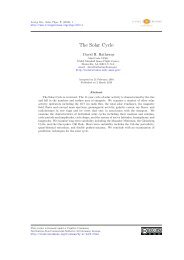PDF (for b&w printout) - Living Reviews in Solar Physics
PDF (for b&w printout) - Living Reviews in Solar Physics
PDF (for b&w printout) - Living Reviews in Solar Physics
You also want an ePaper? Increase the reach of your titles
YUMPU automatically turns print PDFs into web optimized ePapers that Google loves.
The Sun <strong>in</strong> Time: Activity and Environment 37<br />
For the most active stars, LX is somewhat suppressed, <strong>for</strong> reasons that are not well understood.<br />
The stars are <strong>in</strong> a “super-saturated” regime (Randich et al. 1996, see discussion <strong>in</strong> Güdel 2004).<br />
The overall rotation and activity history of a solar analog star from ZAMS to the term<strong>in</strong>al<br />
stages of its MS life thus proceeds roughly as follows:<br />
• A star enters on the MS as a fast rotator although the rotation period is not unique, depend<strong>in</strong>g<br />
on the previous star-disk <strong>in</strong>teraction history. The star thus typically beg<strong>in</strong>s its MS life <strong>in</strong> the<br />
saturation regime where LX ≈ (2 – 4)×10 33 erg s −1 . Although it sp<strong>in</strong>s down as a consequence<br />
of its magnetic-w<strong>in</strong>d mass loss, there is little evolution of the X-ray (and UV, FUV, EUV)<br />
output.<br />
• At an age of around 20 – 200 Myr, the rotation period has decreased sufficiently so that the<br />
star’s corona drops out of the saturation regime (e.g., Patten and Simon 1996; James and<br />
Jeffries 1997, and Section 17.5.2 <strong>in</strong> Güdel 2004). For a G star, saturation holds as long as<br />
P < 1.5 – 2 d.<br />
• Convergence of rotation periods has been achieved at ages of a few 100 Myr, and by that<br />
time a solar analog shows P ≈ 4 – 5 d and LX ≈ 10 29 erg s −1 , i.e., less than 10% of the<br />
saturation value.<br />
• From then on, the lum<strong>in</strong>osity decay law holds, because the rotation period is a function of<br />
age and <strong>in</strong>creases monotonically. This decay law has been observationally tested until the<br />
term<strong>in</strong>al stages of the MS life of a solar analog.<br />
5.5.2 The coronal temperature <strong>in</strong> time<br />
The non-flar<strong>in</strong>g corona of the contemporary Sun shows temperatures of a few MK. Active regions<br />
tend to be hotter than the quiet corona, and consequently, the average coronal temperature dur<strong>in</strong>g<br />
the Sun’s activity maximum is higher than at m<strong>in</strong>imum. Peres et al. (2000) have studied the fulldisk<br />
solar coronal emission measure distribution to f<strong>in</strong>d peak temperatures of ≈ 1 MK and ≈ 2 MK<br />
dur<strong>in</strong>g m<strong>in</strong>imum and maximum, respectively. The correspond<strong>in</strong>g X-ray lum<strong>in</strong>osities amount to<br />
LX ≈ 3 × 10 26 erg s −1 and LX ≈ 5 × 10 27 erg s −1 , respectively. These solar observations suggest<br />
that regions of higher magnetic activity, but also episodes of higher overall magnetic activity, not<br />
only produce higher-lum<strong>in</strong>osity plasma but also higher temperatures. Does this reflect <strong>in</strong> coronae<br />
of stars with widely vary<strong>in</strong>g activity levels?<br />
The spectral evolution of the X-ray and EUV (coronal) Sun <strong>in</strong> time is illustrated <strong>in</strong> Figures 15,<br />
16, and 17. These figures of course support the trend of decreas<strong>in</strong>g flux with <strong>in</strong>creas<strong>in</strong>g age as<br />
described <strong>in</strong> Section 5.5.1, but they reveal other important features:<br />
These spectral features clearly suggest higher temperatures <strong>in</strong> more active, younger solar<br />
analogs.<br />
• In Figure 15, the EUV spectrum shows prom<strong>in</strong>ent l<strong>in</strong>es of highly ionized Fe (Fe xxii, xxiii)<br />
<strong>in</strong> the young EK Dra but these l<strong>in</strong>es rapidly disappear <strong>in</strong> older stars, where l<strong>in</strong>es of Fe xv<br />
and Fe xvi predom<strong>in</strong>ate. This is a signature of hotter overall temperatures <strong>in</strong> the younger,<br />
more active solar analogs.<br />
• In Figure 16, the X-ray spectra of the youngest, most active solar analogs (47 Cas, EK Dra),<br />
aga<strong>in</strong> reveal strong l<strong>in</strong>es from highly ionized Fe and also a prom<strong>in</strong>ent Ne x l<strong>in</strong>e (at 12.1 ˚A);<br />
these l<strong>in</strong>es are <strong>for</strong>med by plasma with temperatures of order 10 MK. In contrast, <strong>in</strong> the<br />
least active star shown (β Com), l<strong>in</strong>es of Fe xvii, Ne ix, and O vii dom<strong>in</strong>ate. These l<strong>in</strong>es are<br />
<strong>for</strong>med at temperatures of 2 – 5 MK.<br />
<strong>Liv<strong>in</strong>g</strong> <strong>Reviews</strong> <strong>in</strong> <strong>Solar</strong> <strong>Physics</strong><br />
http://www.liv<strong>in</strong>greviews.org/lrsp-2007-3



